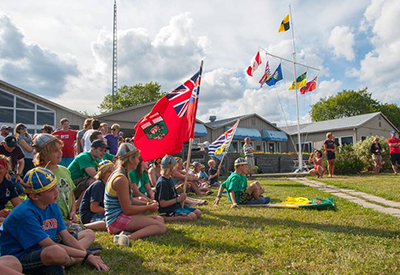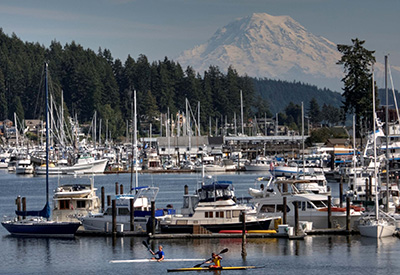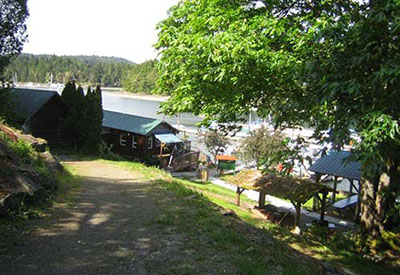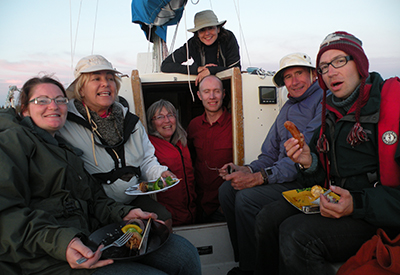Maiden Voyage, Distant Shores

 Every sailor knows it’s bad luck to begin a voyage on a Friday. Why? We’ve never really been able to satisfactorily pin that down. Like most superstitions the origin is a bit murky. Some say it has religious roots relating to Jesus’ death on the cross on Good Friday. Others say it relates to Friday the 13th and that historically bad things often happen on a Friday. Regardless of the reason, it’s a superstition that the brotherhood of sailors, whether racing or cruising, pays heed to.
Every sailor knows it’s bad luck to begin a voyage on a Friday. Why? We’ve never really been able to satisfactorily pin that down. Like most superstitions the origin is a bit murky. Some say it has religious roots relating to Jesus’ death on the cross on Good Friday. Others say it relates to Friday the 13th and that historically bad things often happen on a Friday. Regardless of the reason, it’s a superstition that the brotherhood of sailors, whether racing or cruising, pays heed to.
So it was a real dilemma for us when the 5-day weather window we were waiting for to get out of England and cross the English Channel and Bay of Biscay in late November opened up on a Friday. Especially since this was to be the maiden voyage of our brand new boat, Distant Shores, a Southerly 42RST built by Northshore Yachts in England. It just seemed a bad way to start things off.
We toyed with the idea of leaving just before midnight on the previous Thursday but we were at the year’s largest spring tides on the south coast of England and the timing didn’t work out. Waiting until Saturday might result in getting caught out on the notorious Bay of Biscay before safely making landfall at Cape Finesterre in Spain. Departure day had to be the Friday.
“Sounds like it would be worse luck to pay attention to the superstition, Paul,” I said to my mate of 22 years. Together we had built our previous boat from a bare hull and sailed her without incident to over 50 countries and colonies around the world. “You’ve done so much research on the right weather for this passage and if Friday’s the day, let’s go.” He agreed. But we both felt a bit apprehensive. Traditions die hard.
Our plan for the new boat this year was to sail along the south coast of England then head down the Spanish and Portuguese coasts before jumping off to the Canary Islands where we would join in the migration of yachts crossing the Atlantic to the Caribbean for a winter of tropical island-hopping. It would be our fourth transatlantic passage and honestly we weren’t worried about the ocean crossing. We know it’s generally a nice warm downwind passage from the Canaries to the Caribbean with steady tradewinds and by that point the new boat would have had a thorough shaking-down.
It was the Bay of Biscay that had us worried since it can kick up horribly if you don’t get several days of reliable winds from the north to get across to Spain. Anything from the south would be a head wind and worst of all would be a southwest wind that can push you into the shallower water at the edge of the continental shelf where huge confused seas would build in these conditions. And unfortunately this is the prevailing wind in the winter months.
“Don’t go!” “You’ll never make it.” “You’ll have to wait until next year.” “Your cruising plans are finished for this year, my friends,” were the general reactions we were getting as we continued to prepare for our voyage south.
When we’d put our money down on the new boat and construction began, delivery was scheduled for September, a good time for crossing the Biscay, but as the delivery date slipped to October and then November our chances for a good weather window began decreasing as the frequency of early winter gales began increasing. Some boat insurance companies won’t offer coverage for the Bay of Biscay after October 31st.
Fortunately the company we have insured with for many years while cruising in Europe and the Mediterranean, Pantaenius Yacht Insurance, offered us coverage in November based on our cruising experience and safety record. We would do our research and only when the conditions were right would we attempt this passage.
Paul really is fastidious in his attention to weather information when planning any passages we make. As usual, he had spent the last few months preparing for our upcoming voyage by reading everything available on weather patterns for the area – most especially the Bay of Biscay – that lies off the French coast and along the continental shelf. He found weather sites on the Internet and we began “virtual voyages” testing our ability to predict good departure conditions and watching what happened as conditions developed.
Besides published guides, manuals, and cruising association bulletins, the Internet is a great resource for voyage planning these days. So many cruising sailors post websites or write detailed blogs sharing their knowledge and experience in every imaginable cruising destination. There are many weather sites some giving historical data and it appeared that although the frequency of windows was less often there had always been at least one in November over the last 6 years. With the modern weather forecasting available today we felt there was a good chance to pinpoint a weather window and avoid getting caught out at this time of year. If we moved now we could get south and still have lots of weather opportunities for the upcoming transatlantic passage best done from the Canary Islands to the Caribbean anytime from the end of November through February. It can be a bit of a domino effect if you don’t get the timing of weather and the seasons right.
The Northshore Yachts crew was still making adjustments to the boat based on the “snag list” that had resulted from sea trails and we were still unpacking the three large wooden crates containing the gear we had shipped from our old boat, Two-Step. The crates contained everything from life jackets, to anchors, pots and pans, bedding and linens, clothes, foul weather gear, our collection of world cruising guides and charts plus other resource books, all our dive gear, my sewing machine, tools, spare parts, extra lines, you name it!
Joining us on this first leg of the voyage from England to the Canary Islands was friend, Gord Zimmerman of Bobcaygeon, Ontario, who with his wife, Sue Ferguson, cruises aboard their Sidelmann 37, “Lady Simcoe”. Gord is a life-long racing and cruising sailor but had never sailed in Europe and wanted to experience some longer offshore passages. Throughout the 19 years that Paul and I have been cruising internationally, we have always made passages with just the two of us onboard. However, since this first leg south was going to be made at a “delivery” pace in cold weather aboard a new boat, and Gord was a trusted and experienced sailor looking for adventure, we felt he was up to the task and would be fun to have along.
Departure day, Friday November 23rd, arrived with sun shining and ideal conditions as forecast – north winds for a fast overnight passage from Chichester to Falmouth. It was just bloody cold! We were dressed in so many layers of fleece and foul weather gear we could barely move as we waved goodbye to everyone at Northshore Yachts. They have built a beautiful and seaworthy boat for us and couldn’t do enough to make the boat as perfect as could be.
The boat sailed like a dream as we did our first overnight sail from Chichester along the south coast of England to Falmouth in the west – the best position to jump off to cross the English Channel and the Bay of Biscay since it gets you right out into deep water. But as the sun set that first night the temperatures dipped to freezing. Thanks to the new Mastervolt generator we’d had installed we could run our heaters and stay warm below but the person on deck on watch had to stuff a hot water bottle down their jacket for warmth. At midday the next day, we were headed by west winds so pulled into the picturesque little harbour at Fowey (pronounced Foy) a little east of Falmouth where we spent the night.
The next morning conditions were good for continuing on to Falmouth, a town we know with lots of chandleries, hardware and grocery stores, and cruising friends to greet us. When we arrived in Falmouth local sailing friend, Peter Flutter, directed us to the fuel dock for a final top-up and pep talk, then whisked us off to his father’s home where Peter’s lovely lady, Sue, was preparing Sunday roast and had kindly invited us to join in. It was just what 3 tired hungry sailors needed – good for the body and soul – and fuelled us up for the passage ahead. Then we went mad running errands including purchasing another few sets of “thermals”, thick gloves, and balaclava hats.
At midnight that night we set off from Falmouth and started our crossing of the English Channel that has some of the heaviest ship traffic in the world. Lights blinked around us constantly in the darkness and on the radar screen. One of the new Raymarine navigation systems we have aboard “Distant Shores” is AIS that stands for Automatic Identification System. All large ships broadcast information including their name, size, course and speed, destination and the system will calculate the closest proximity to you and give the time of this closest contact. It took away a lot of stress in the VERY busy shipping lanes along our route. It was especially helpful when we wanted to contact an oncoming ship since we could call it by name. We all had nice chats with various crew on passing ships.
As it turned out, a high pressure system moved in and remained settled throughout our whole voyage across the English Channel and Bay of Biscay plus the Spanish and Portuguese coasts. After only a couple of hours of sailing out of Falmouth we had to turn on the motor and so it continued. As we rounded Cape Finesterre after successfully crossing the Bay of Biscay four days out of Falmouth it was so flat calm the stars were reflected in the water!
But the gales howled into the UK shortly after our escape from England and as we followed calm and warming weather southwards, peeling off layers of foul weather gear as we went, we felt the effects of the gales far to the north by means of a huge ground swell. The wave heights were an astonishing 5 metres and despite not having enough wind to sail we rode waves like roller coasters for most of our voyage.
We had hoped to continue on straight to Lisbon from Falmouth, but due to the lack of wind we had to stop just south of Cape Finesterre at the lovely Club Nautico in Portosin, Spain, in the Ria Muros to get fuel, before continuing south to Lisbon on December 1st. There, at Caiscais Marina, Gord and Paul set to work on some new rigging projects while I reprovisioned and tried to get our quickly stowed gear sorted out and rearranged a little better.
Gord loves rigging and made some excellent suggestions that included the design and rigging of the new boom preventer/barberhauler. This consisted of a 3/8″ D-ring bolted through the caprail with strong backing plates to secure a strop and turning block. This is all controlled with port and starboard lines to a block and clutch making it safe and easy to control from the cockpit.
After waiting for a thick fog to lift, we set sail for the Canary Islands on Wednesday, December 5th. And low and behold we got some wind at last! Unfortunately it wasn’t in the right direction for the Canaries but gave us a nice course for the Portuguese island of Madeira so we all agreed to just keep sailing and make an unexpected stop there. This is the beauty of electronic navigation! With our Raymarine E120 plotter and Navionics Platinum charts not only do we have detailed charts of all harbours so we can safely change our plans; the Platinum charts include written pilot guides and aerial photos of many harbours. Fabulous tools!
We poled out the jib and sailed wing and wing a lot of the way adjusting the depth of Distant Shores’ swing-keel for best performance. With the keel fully up the boat draws 2′ 9″; fully down it draws 9 feet. Great fun! And the weather was getting warmer too. One day we came on deck to find Gord in nothing but short red shorts and a Santa hat! Oh boy, Christmas was drawing near.
On Sunday December 9, we made a sunrise landfall at Funchal Marina in Madeira where local sailors welcomed us. The marina is not large and usually visiting yachts are required to raft against the quay but since we were arriving so late in the season several local yachts were already hauled out and the harbourmaster was able to give us a slip to tie up in on one of the floating pontoons. This meant we didn’t have to worry about the tides or scramble up a barnacle-encrusted wall.
We spent a couple of days enjoying the waterfront activities that included street festivals, folkloric music, and spectacular Christmas lights. However nothing gave me so much delight as the city market in Funchal – a delight to the senses of any sailor who has just spent so many days on the sea. Madeira is known as “the garden of the Atlantic” since every imaginable fruit, vegetable and flower is grown there. I stocked up on fresh produce and we prepared once again to head to sea. Two days sail to the south lay the Canary Islands, our jumping off point to cross the Atlantic Ocean. The new boat had been sailing beautifully and we were gradually getting her ship shape. The ocean called. We were ready. Or so we thought.





























